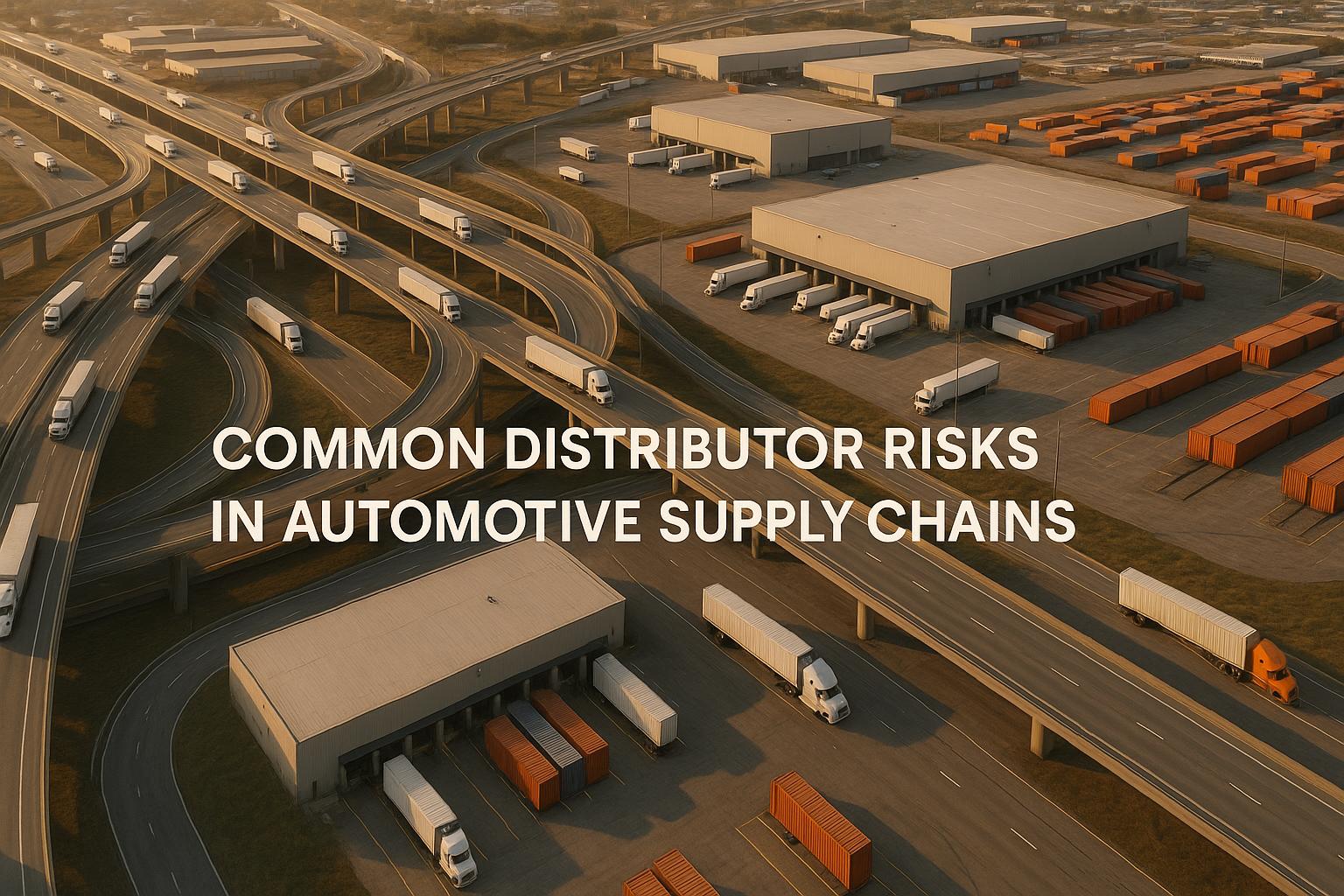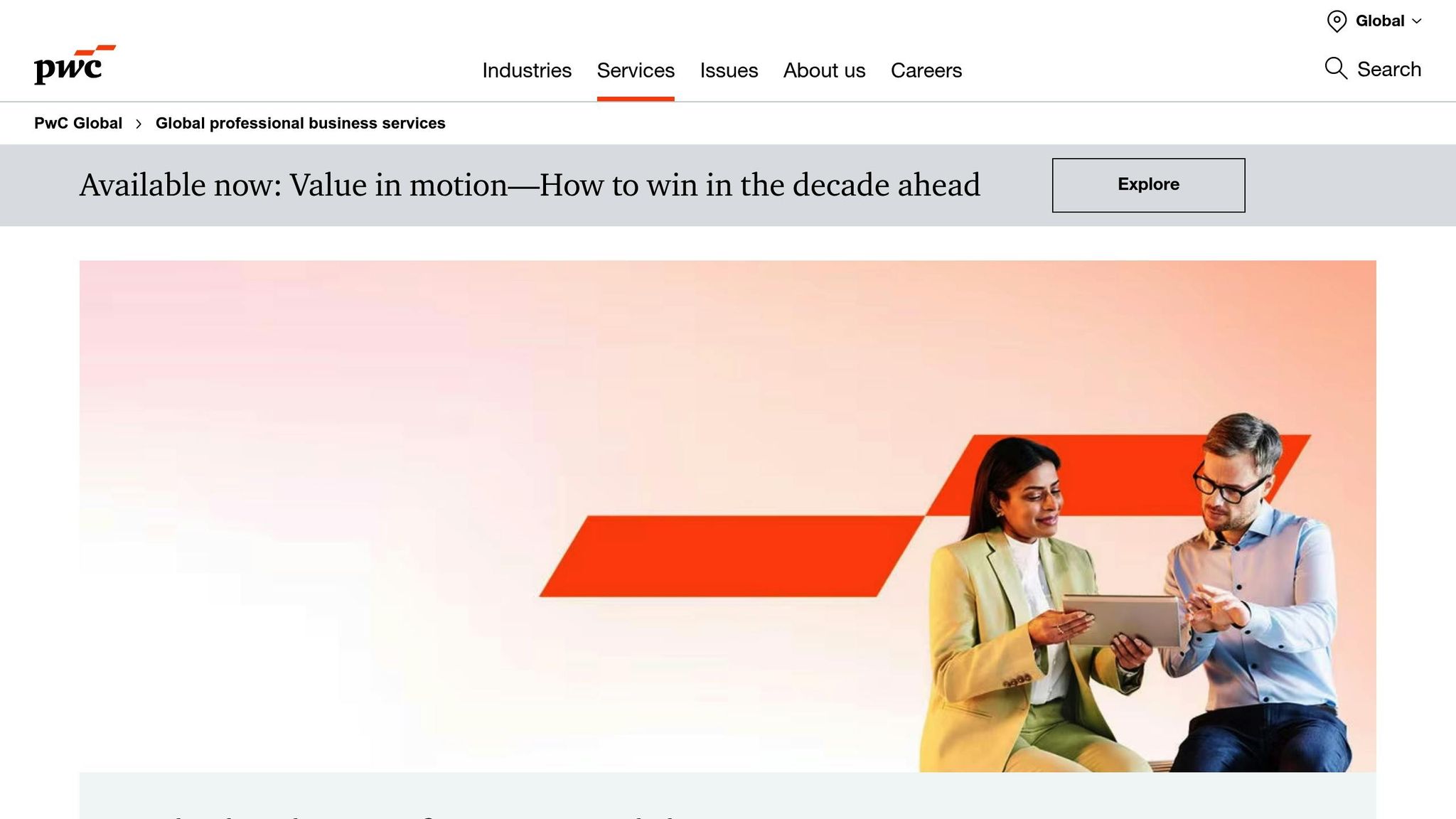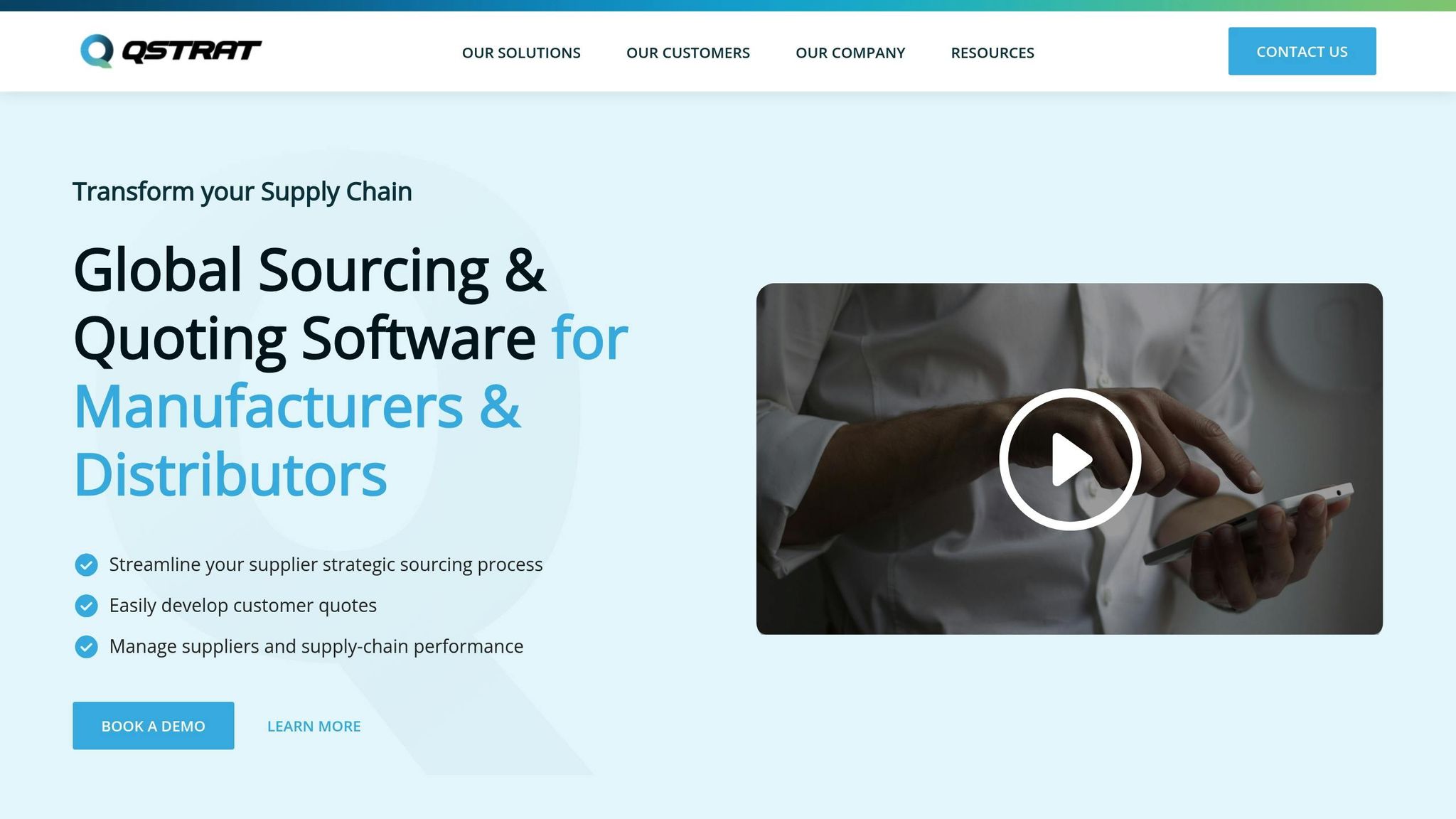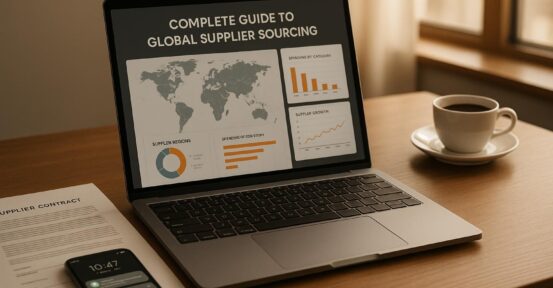
Distributors are the backbone of automotive supply chains, but they face growing risks that can disrupt production and inflate costs. In 2025, over 80% of automotive companies reported supply chain disruptions, with half lasting more than a month. These challenges stem from:
- Regulatory pressures: Stricter laws like the Uyghur Forced Labor Prevention Act (UFLPA) and ESG reporting requirements are raising compliance costs and risks.
- Financial instability: Distributors struggle with volatile raw material prices, tight margins, and rising competition, leading to bankruptcies and manufacturing delays.
- Material shortages: Critical components like semiconductors and lithium remain in short supply, halting production and increasing costs.
- Climate-related disruptions: Extreme weather events, such as flooding and hurricanes, are damaging infrastructure and delaying shipments.
- Limited supply chain visibility: Only 16% of manufacturers map their suppliers beyond tier one, leaving them vulnerable to hidden risks.
Key solutions include:
- Using tools like blockchain and supplier traceability systems for better visibility.
- Diversifying suppliers to reduce dependency on single sources.
- Monitoring distributor financial health and creating contingency plans.
- Leveraging digital platforms like QSTRAT for real-time risk tracking, automated compliance, and supplier management.
Bottom line: Managing these risks is essential for supply chain stability and competitiveness. Companies that adopt data-driven, tech-enabled strategies can reduce disruptions, cut costs, and stay ahead in a volatile market.
Successfully Navigating Supply Chain Disruptions – Sponsored by PwC

Regulatory and Compliance Risks
Automotive distributors face a maze of regulations that influence nearly every aspect of their operations. From labor laws to environmental standards, staying compliant has become a constant challenge, especially as supply chains grow more complex.
Changing Regulatory Requirements
The rules governing supply chains are evolving rapidly. Take the Uyghur Forced Labor Prevention Act (UFLPA), for example. This law bans the import of goods tied to forced labor in China, requiring companies to prove their supply chains are free of such practices. To comply, distributors must adopt rigorous supplier vetting processes and maintain detailed records – or risk having their shipments halted at customs.
Then there’s the growing emphasis on Environmental, Social, and Governance (ESG) reporting. These mandates require companies to disclose detailed information about their environmental impact, labor practices, and governance standards. For distributors, this means rethinking supplier evaluations and operational strategies to meet these new expectations.
On top of that, climate-related disclosure requirements are adding another layer of complexity. These regulations push companies to assess and report on how climate risks could impact their operations. For distributors, this means digging deep into their supply chains to understand and disclose potential vulnerabilities. All these changes don’t just increase operational complexity – they also drive up costs, both directly and indirectly.
Costs of Non-Compliance
Failing to meet regulatory standards can be financially crippling. The direct costs are steep: fines, shipment delays, and even product seizures can derail production schedules and disrupt operations. For instance, when shipments are detained at customs due to compliance issues, entire production lines can grind to a halt.
But the indirect costs can be even worse. Consider a case where a supplier was linked to forced labor practices. Beyond the immediate penalties and shipment disruptions, the company faced negative media coverage and long-term reputational damage.
A tarnished reputation can take years to repair. Public backlash, loss of customer trust, and exclusion from key markets are common consequences of compliance failures. In today’s hyper-connected world, news of violations spreads fast, making it harder than ever for companies to bounce back.
Compliance Solutions
Navigating modern compliance challenges requires more than just traditional audits. Here are some tools and technologies helping distributors stay ahead:
- Blockchain audit trails: By creating tamper-proof records, blockchain ensures transparent and trustworthy supply chain documentation. This technology makes it nearly impossible to alter compliance records, giving regulators confidence in the data.
- Supplier traceability systems: These systems provide visibility across multi-tier supply chains, helping distributors track components and materials from their origin to final assembly. This ensures compliance at every stage.
- Digital documentation tools: Automating compliance reporting reduces manual errors and simplifies audits. These platforms can gather data directly from suppliers, generate necessary reports, and maintain the detailed records regulators demand.
Together, these solutions not only help companies meet regulatory requirements but also reduce the risk of costly compliance failures.
Financial Instability and Supplier Distress
The automotive industry is grappling with a growing challenge: financial instability among distributors. When distributors face financial troubles or insolvency, the consequences can ripple through the supply chain, halting production, driving up costs, and straining long-standing supplier relationships.
Growing Financial Risks
Distributors are under increasing pressure due to volatile raw material prices, razor-thin profit margins, and fluctuating currency values. For electronics distributors, rapid inventory obsolescence and tighter credit conditions add to the strain, while plastics distributors contend with oil price swings and mounting regulatory expenses. Combined with rising competition, these factors amplify financial instability across the supply chain.
The semiconductor shortage of 2020–2021 highlighted just how fragile the situation can be. Financially distressed electronics distributors struggled to meet demand, causing significant production stoppages for U.S. automakers.
Effects of Financial Distress
When distributors face financial distress, the resulting delivery delays and inventory shortages disrupt manufacturing schedules. This often forces manufacturers to pay higher prices to secure materials, further complicating operations.
Consider the 2016 steel shortage that disrupted Toyota‘s production. A key steel supplier’s financial and operational troubles caused a two-month production halt, costing Toyota millions in lost output. This prompted the company to overhaul its supplier risk management strategy.
A similar scenario unfolded in 2021 when a major automotive OEM suffered a six-week delay after one of its key electronics distributors declared bankruptcy. The financial fallout was severe, with losses estimated at $45 million.
These examples underscore the urgent need for manufacturers to adopt risk mitigation strategies.
Risk Reduction Strategies
Automakers are taking proactive steps to reduce their exposure to distributor instability. One critical measure is monitoring distributors’ financial health by analyzing credit ratings, debt-to-equity ratios, and cash flow statements. Early warning signs – such as delayed payments to suppliers, sudden changes in credit terms, and shrinking inventory levels – can signal potential trouble.
Diversifying the supplier base is another key strategy. By reducing reliance on a single distributor, manufacturers can lessen the impact of financial disruptions. This involves mapping the supply chain to identify components at risk due to single-source dependencies and qualifying multiple suppliers for critical parts. For instance, the automotive OEM that faced $45 million in losses responded by mapping its supply chain and diversifying its suppliers, significantly lowering its future risks.
Contingency planning also plays a vital role. Measures like maintaining safety stocks, establishing alternative suppliers, and deploying rapid response teams can help manufacturers navigate disruptions more effectively. Technology platforms such as QSTRAT enhance these efforts by offering real-time financial tracking and automated supplier analytics, enabling manufacturers to identify at-risk distributors quickly and take immediate action.
Material Shortages and Supply Disruptions
Material shortages can bring automotive production to a standstill. With modern vehicles comprising thousands of components, even a small disruption in the supply chain can ripple through the entire manufacturing process.
Key Material Shortages
The shortage of semiconductors continues to wreak havoc on the automotive sector. Since 2020, this global issue has forced automakers to slow or halt production, leading to billions in lost revenue. These chips are essential for engine controls and infotainment systems, making them difficult to substitute.
Lithium is another material under strain. As electric vehicle (EV) production grows, the demand for lithium – used in batteries – has outpaced supply. Limited mining and processing capacity means even minor disruptions can drastically affect production timelines.
Rare earth elements also pose challenges. These materials are critical for electric motors and advanced electronics, but their production is heavily concentrated in a few regions. Geopolitical tensions or regulatory changes in these areas can quickly disrupt availability.
The factors driving these shortages include surging global demand for EV components, natural disasters impacting production, geopolitical trade restrictions, and insufficient mining or processing capacity. The COVID-19 pandemic further highlighted the fragility of just-in-time inventory systems, which many manufacturers had relied on for decades.
Compounding these issues is the automotive industry’s reliance on a limited number of suppliers.
Single-Source Risks
Beyond material shortages, depending on a small pool of suppliers adds another layer of vulnerability. Relying on single distributors or regionally concentrated suppliers can create significant risks.
Geographic clustering makes the problem worse. When suppliers are located in specific regions, supply chains become exposed to trade disputes, export restrictions, or local disruptions. The semiconductor crisis underscored this risk, as many automakers depended on a few fabrication facilities in Asia.
Recent events, like flooding in Valencia, Spain, have highlighted these vulnerabilities. The disaster inundated warehouses and disrupted operations, forcing a manufacturer to close its plant and leaving hundreds of workers without work.
The scale of these disruptions is clear. Over 80% of automotive companies have faced supply chain interruptions in the last five years, with half of those lasting more than a month. A McKinsey survey also revealed that 71% of executives expect disruptions to increase, citing material shortages and rising costs as major concerns.
Prevention Measures
Solving these challenges requires proactive strategies like diversified sourcing and advanced digital tools. Engaging multiple suppliers for critical materials can reduce reliance on a single source, though it demands careful supplier management and qualification.
Supply chain mapping and real-time visibility are equally important. By tracking material flows and mapping supplier networks down to sub-tier levels, manufacturers can identify bottlenecks and geographic risks. Real-time monitoring helps detect potential shortages early.
Another approach is strategic inventory management. Maintaining safety stock for high-risk components, combined with accurate forecasting, can mitigate disruptions. Meanwhile, material recycling – such as reclaiming lithium – can reduce dependency on primary sources and align with sustainability efforts.
Building long-term supplier partnerships also helps. These relationships go beyond traditional transactions, involving joint planning, shared risk assessments, and coordinated contingency plans.
Digital platforms like QSTRAT enhance these efforts by streamlining supplier evaluations and tracking market trends. These tools collect extensive data – over 50 elements – on qualified suppliers during bidding, aiding in diversified sourcing. AI-powered features can flag unusual price spikes, signaling potential material shortages or market instability.
Striking a balance between cost efficiency and supply chain resilience is crucial. While relying on a single supplier may cut costs initially, it significantly increases risk. A smarter approach includes leveraging digital risk management tools, maintaining reserves of key materials, and creating flexible contracts that allow for quick adjustments during disruptions.
sbb-itb-827f251
Logistics and Climate-Related Disruptions
Logistics challenges, combined with climate-related disruptions, highlight the fragility of global supply chains. Beyond material shortages and supplier issues, these factors can derail even the most meticulously planned operations, creating ripple effects that impact distributor networks and production timelines.
Global Logistics Challenges
The automotive industry’s reliance on just-in-time (JIT) inventory systems has long been a double-edged sword. While JIT minimizes inventory holding costs, it also leaves manufacturers with little room for error. A single delay in parts delivery can bring production to a grinding halt. This vulnerability became glaringly obvious during the COVID-19 pandemic, when global shipping delays and material shortages caused widespread production stoppages and financial losses.
Geopolitical tensions further complicate the logistics landscape. Trade wars, tariffs, and border restrictions can disrupt material flows, forcing manufacturers to restructure their supplier networks. For instance, a proposed 10% tariff on imported automotive parts could significantly increase costs, pushing companies to find new suppliers or even relocate production. Adapting to such policy changes often requires manufacturers to quickly establish relationships with unfamiliar suppliers and adjust shipping routes to maintain operations.
Other logistical headaches include port congestion, container shortages, and fluctuating freight rates. These issues create unpredictable delays that ripple through global supply chains, affecting distributor reliability and extending delivery times.
Climate Change Effects
Climate-related disruptions are becoming harder to ignore, as extreme weather events grow in frequency and severity. Hurricanes, floods, wildfires, and severe storms can wreak havoc on infrastructure, disrupt transportation routes, and delay shipments for weeks or even months. For example, recent flooding inundated warehouses and distribution centers, causing significant supply chain disruptions.
In the U.S., hurricanes along the Gulf Coast and Eastern Seaboard, as well as wildfires in the West, frequently disrupt automotive supply chains. These events damage ports, flood storage facilities, and render key transportation routes impassable, leading to inventory shortages, longer lead times, and reduced distributor reliability.
Building Resilience
To address these growing challenges, manufacturers need to focus on building resilient supply chains. This involves adopting strategies that combine better visibility, predictive analytics, and strong logistics partnerships.
Improved supply chain visibility is critical. By mapping multi-tier supplier networks, manufacturers can identify potential vulnerabilities, such as high-risk regions or bottlenecks in transportation routes. This allows for proactive contingency planning.
Predictive analytics also play a key role. These tools enable real-time risk monitoring and help manufacturers make quick inventory adjustments. By forecasting potential disruptions, companies can optimize inventory levels and respond swiftly to changing conditions, minimizing downtime and ensuring distributor reliability .
Digital tools like QSTRAT further enhance resilience by streamlining supplier management and automating risk monitoring. These platforms integrate data across systems, providing manufacturers with a clearer picture of their supply chain.
Strong partnerships with logistics providers are equally important. Long-term relationships can offer flexible routing options, priority access during disruptions, and collaborative contingency planning. These partnerships may involve shared risk assessments and joint investments in infrastructure, ensuring faster responses to emerging threats .
Finally, contingency plans for natural disasters and geopolitical events are essential. These plans should include alternative transportation routes, backup inventory strategies, and clear communication protocols with suppliers and customers. Regular testing and updates ensure these plans remain effective as conditions evolve .
While building resilience may increase costs initially – through measures like supplier diversification and maintaining safety stock – it ultimately safeguards operations and provides a competitive edge when disruptions strike.
Technology-Driven Risk Mitigation
Automotive distributor networks are under increasing pressure to adopt advanced digital solutions for managing risks. In today’s unpredictable market, relying on outdated systems simply isn’t an option. Modern technology platforms have become essential tools for navigating these challenges.
Digital Transformation Benefits
New sourcing and quoting tools are revolutionizing how manufacturers handle distributor relationships and reduce risks. These platforms offer real-time insights into supplier performance, inventory levels, and potential disruptions – capabilities that traditional manual systems can’t match.
One of the key advantages of these systems is their ability to centralize data and provide continuous monitoring across distributor networks. They can quickly identify supplier distress, material shortages, or compliance issues, closing a critical visibility gap. For instance, only 16% of automotive companies have mapped their tier-two suppliers and beyond. Digital platforms address this shortfall by offering detailed supplier mapping and performance tracking, extending visibility deep into supply chains.
The operational impact is hard to ignore. Companies using advanced sourcing tools report faster quoting cycles, better supplier response rates, and stronger supply chain resilience. These tools streamline supplier selection, automate quoting, and provide precise cost analysis – drastically reducing errors and delays. This shift to digital systems creates a strong foundation for specialized tools like QSTRAT, which take supply chain visibility to the next level.
QSTRAT as a Solution

QSTRAT brings together CRM, ERP, costing, quoting, and sourcing into one powerful platform, offering manufacturers unparalleled visibility and control.
The system’s supplier performance tracking feature monitors over 50 data points, enabling thorough evaluations during product development or engineering changes. This level of detail allows manufacturers to proactively identify risks and assess suppliers in ways that older methods simply can’t match.
Take BAE Systems as an example. They successfully implemented QSTRAT alongside their existing MFG/PRO and Cyberquery tools. According to BAE Systems:
"By leveraging QSTRAT’s suite of products with our existing MFG/PRO and Cyberquery solutions we can now accurately quote, track successes and measure our accuracy of our projected costs versus our true costs when entered into our MFG/PRO system."
QSTRAT also offers real-time risk visibility, providing instant access to supplier responses and decision-making tools for comparisons and awards. These features are invaluable during disruptions, allowing for quick supplier pivots or emergency sourcing decisions. Additionally, its seamless integration ensures data flows smoothly across procurement, sales, and operations. This unified data view helps improve forecasting, inventory management, and responses to emerging risks.
Automation Benefits
Beyond visibility, QSTRAT’s automation features simplify critical workflows. Tasks that used to take hours – or even days – are now completed in minutes, with far greater accuracy and consistency.
For example, automated workflows eliminate delays in supplier communications and compliance processes. QSTRAT’s two-way communication system generates automated emails, handles necessary documents, and validates supplier submissions, reducing errors and ensuring reliable data.
This is particularly impactful in light of the 17% rise in reported human rights violations in EU automotive supply chains between 2022 and 2023. Automation simplifies supplier onboarding, compliance tracking, and ESG assessments, cutting quoting cycle times by 40%.
Additional automated features, like requisitions, notifications, and approvals, keep all stakeholders engaged during sourcing events. AI-powered tools flag unusual quotes and support benchmarking efforts, helping manufacturers lower material costs without sacrificing quality.
For those focused on performance metrics – such as supplier on-time delivery, incident response times, compliance audit scores, or disruption rates – automation ensures consistent data collection and analysis. This data is critical for refining risk mitigation strategies and maintaining a competitive edge.
Conclusion: Managing Distributor Risks for Supply Chain Resilience
The automotive industry is grappling with increasingly intricate supply chain challenges. Recent data reveals that over 80% of companies experienced disruptions in the past five years, and half of these disruptions stretched beyond a month. These prolonged interruptions have led to production delays and significant revenue losses, reverberating throughout global supply networks. This highlights a pressing truth: conventional risk management methods are no longer enough.
Addressing these issues requires a strategic overhaul. The risks discussed – ranging from regulatory hurdles and supplier financial instability to material shortages and climate-related threats – demand a comprehensive, digitally-driven approach. More executives are recognizing that resilience isn’t just about weathering disruptions; it’s about positioning their businesses to thrive in the face of them.
The solution lies in adopting proactive, data-focused strategies that push visibility beyond tier-one suppliers. Companies leading the way in overcoming these challenges often share a few key traits: they embrace digital transformation, diversify their supplier networks, and foster transparent relationships with distributors. Crucially, they rely on integrated platforms that streamline sourcing, quoting, compliance monitoring, and performance management into a single system. Technology becomes the bridge that turns insights into actionable strategies.
Tools like QSTRAT exemplify this approach, offering integrated solutions that enhance efficiency. By automating critical workflows, providing real-time supplier performance data, and seamlessly integrating with existing ERP and CRM systems, such platforms enable businesses to shift from reactive to proactive management. The results speak for themselves: 30% shorter disruption durations and 20% cost reductions in compliance-related activities underscore the tangible benefits of these technological solutions.
In an increasingly complex global market, supply chain resilience is not a one-time achievement but an ongoing process. Manufacturers and distributors who commit to robust risk management strategies today will set the pace for tomorrow – transforming vulnerabilities into opportunities and ensuring their competitive edge in the ever-evolving landscape.
FAQs
What steps can automotive companies take to comply with regulations like the Uyghur Forced Labor Prevention Act and ESG reporting requirements?
To keep up with changing regulations like the Uyghur Forced Labor Prevention Act and ESG reporting requirements, automotive companies need reliable tools to oversee supplier performance and maintain transparency throughout their supply chains.
Platforms such as QSTRAT can simplify supplier sourcing, automate data collection, and track compliance metrics effectively. By taking this proactive route, companies can minimize risks while building stronger trust with both stakeholders and customers.
How can automotive manufacturers address financial risks posed by unstable distributors?
Automotive manufacturers can shield themselves from financial risks tied to unreliable distributors by taking a few smart steps. Regular checks on the financial stability of distributors, spreading out partnerships across a broader network, and setting up strong performance tracking systems can go a long way in avoiding potential hiccups.
Leveraging cloud-based sourcing and quoting software can also make a big difference. These tools simplify processes, help keep a closer eye on supplier performance, and cut costs, ultimately creating a stronger and more dependable supply chain.
How can digital tools like QSTRAT improve supply chain visibility and help mitigate risks such as material shortages or climate-related disruptions?
Digital tools like QSTRAT are game-changers when it comes to improving supply chain visibility and resilience. By simplifying supplier sourcing, automating quoting workflows, and keeping tabs on supplier performance, QSTRAT empowers manufacturers and distributors to make quicker, smarter decisions.
Built on a cloud-based platform, QSTRAT facilitates real-time data sharing and collaboration across global supply chains. This level of transparency helps businesses respond more efficiently to challenges like material shortages or climate-related disruptions. Plus, its ability to integrate with systems like CRM, ERP, and costing tools ensures smoother operations and more effective supply chain management.



